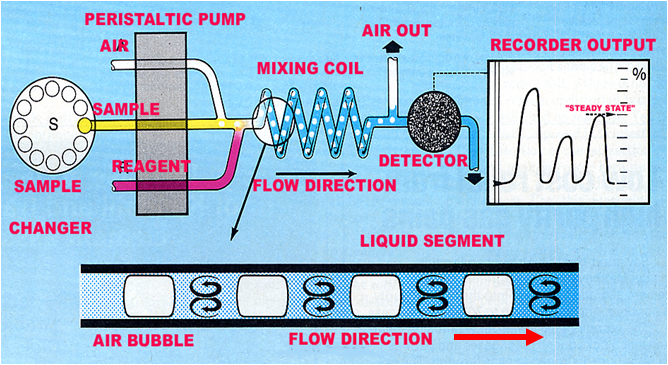FIA & AutoAnalyzer
5.1.7.
In 1956, Leonard Skeggs conceived the idea of automating reagent based assays on a continuous flow basis. The salient feature of his concept was the use of air segmentation, which prevented carryover within the train of samples, during transport to a flow through detector. This allowed the use of long reaction coils, which facilitated homogenous mixing within individual liquid segments, and provided ample time for reactions to reach equilibrium. Skeggs’ invention became both a technical and a commercial success. The Technicon Company produced the instrument and distributed it worldwide, thus becoming a leader in the field of automation of clinical and industrial assays. For almost 20 years, air bubbles were viewed as the essential component of continuous flow analytical systems.

It was natural (and naïve) to write to my old acquaintance (who had taught me how to run AutoAnalyzer), Dr. Holy, in April 1975, letting him know that we had done away with the bubbles. Within a month, we were on our way to the Technicon headquarters in Tarrytown, New York, Elo from Denmark and I from Brazil. We gave a seminar and made a phosphate method demonstration. Soon, the technical director and his staff were injecting samples and admiring their results. We were offered a contract that bound us tightly, and provided moderate funds for our research and our ski vacations – and Technicon would have exclusive rights to produce FIA instruments. We assigned our Danish patent rights to Technicon. However, when we supplied the text of the Danish patent application, problems began. In brief, Technicon’s patent attorney, after consulting other patent specialists, pronounced FIA non-patentable. The technical director deemed the technique impractical. (Selected parts of his opinion were later published [70]). At the end of June, only 2 months before our Danish patent expired, Technicon voided the agreement. We were unhappy, but we were free of contract restraints and determined to promote FIA. We published experimental evidence of FIA’s validity [6,9]. A year later, we met Rune Lundin, Torbjorn Anfalt, and Bo Karlberg from the Swedish company Bifok AB. They soon designed and produced the first commercial FIA instrument. Bo also helped us with the patents listed below. These patents were never successfully challenged, were seldom respected, and have now expired.










